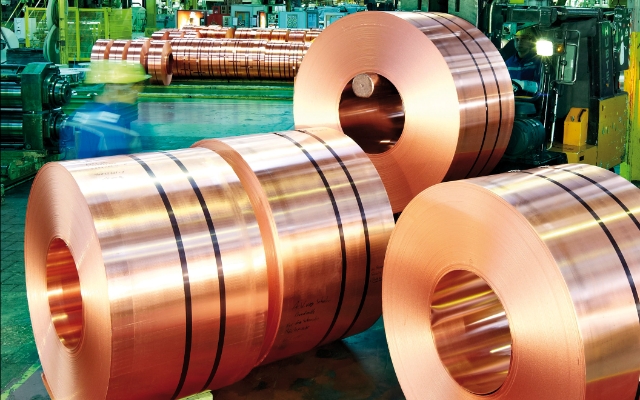From Art to Performance: The Many Applications of Unique Copper Products
From Art to Performance: The Many Applications of Unique Copper Products
Blog Article
Just How Copper Products Contribute to Lasting Practices in Numerous Markets
Copper items are increasingly recognized for their considerable contributions to sustainable methods across multiple sectors, driven by their inherent properties such as performance, recyclability, and resilience. In renewable resource systems, as an example, copper boosts the performance of solar and wind technologies, while its application in building decreases waste via durability. The material's antimicrobial features use appealing advantages in medical care settings. As industries seek to adopt even more lasting practices, the role of copper might prove essential in attaining ecological goals. What ramifications might this have for future advancements in sustainability?
Copper in Renewable Resource
Copper plays a vital function in the development of eco-friendly power technologies, functioning as an essential conductor in numerous applications. Its remarkable electrical conductivity and resistance to corrosion make it a suitable material for electrical circuitry, which is crucial in solar panels, wind turbines, and energy storage space systems. In solar photovoltaic systems, copper is used in the interconnections and circuitry, making it possible for reliable energy conversion from sunlight to electrical power.
In wind energy, copper is essential to the generators and transformers that transform kinetic energy into electrical power, guaranteeing optimum efficiency and integrity. In addition, the need for electrical automobiles (EVs) is enhancing, with copper being a crucial component in batteries, electric motors, and charging framework. The shift to EVs considerably boosts the need for copper, as these vehicles typically utilize 4 times a lot more copper than traditional interior combustion engine cars.
As the world looks for to minimize climate adjustment and shift to lasting power sources, copper's role comes to be significantly important. The material not only boosts the efficiency and durability of renewable resource systems but additionally supports the more comprehensive objective of lowering greenhouse gas emissions and advertising a lasting future.
Eco-Friendly Construction Materials
Over the last few years, there has been a notable shift towards the adoption of environmentally friendly construction materials in action to expanding environmental concerns. This change is motivated by the requirement for sustainable options that minimize ecological footprints while preserving architectural stability and aesthetic allure.
Copper, recognized for its longevity and recyclability, has actually emerged as an essential gamer in this industry. It can be used in roofing, plumbing, and electrical systems, adding to energy performance and decreasing waste. Copper's longevity implies less substitutes gradually, additional improving its sustainability profile.
In addition, products such as bamboo, reclaimed timber, and reused steel are getting popularity. These options not only supply reduced environmental effect yet also advertise source preservation. As constructing codes significantly emphasize sustainability, contractors and architects are integrating these materials into their projects, promoting advancement in style.
The raising fostering of environmentally friendly construction products reflects a wider dedication to sustainability in the developed atmosphere. By prioritizing these products, the construction industry can substantially decrease its carbon footprint, straighten with regulatory criteria, and sustain a healthier community for future generations. This pattern notes a crucial action in the direction of a more sustainable future in construction.
Copper's Role in Health care
Recent research studies have highlighted the substantial function of copper in medical care settings, especially as a result of its antimicrobial buildings. Copper surfaces have actually been revealed to lower the presence of pathogens, consisting of germs and viruses, by up to 99.9% within a brief period. This remarkable efficacy makes copper an indispensable product for high-touch surfaces in hospitals, such as doorknobs, bed rails, and IV poles, therefore adding to enhanced infection control procedures.
In enhancement to its straight antimicrobial effects, copper additionally contributes in the more comprehensive context of medical facility sustainability (Copper Products). By integrating copper right into clinical devices and furnishings, health care centers can reduce the incidence of healthcare-associated infections (HAIs), which not just enhances client end results yet likewise lowers the costs connected with prolonged hospital keeps and extra therapies
In addition, copper's sturdiness and recyclability align with sustainable methods, enabling liable source administration. As medical care systems progressively focus on both person security and environmental stewardship, the integration of copper items discover this is becoming more common. This dual benefit highlights copper's essential payment to a much healthier, much safer, and a lot more sustainable healthcare environment.
Sustainability in Transportation

In addition, copper's longevity and rust resistance add to the long life of transport framework (Copper Products). In rail systems, as an example, copper elements improve the dependability and effectiveness of signaling and power systems, essential for minimizing hold-ups and power consumption. In addition, copper's duty in renewable resource systems, such as solar and wind, sustains lasting transportation solutions by providing tidy power for electric transit options
Investments in copper technology not only foster sustainability however likewise promote economic development and task production in environment-friendly sectors. As sectors make every effort to fulfill stringent ecological guidelines, the application of copper products in transportation becomes an essential technique in achieving sustainability objectives and promoting a cleaner, more efficient future.
Copper and Circular Economy
As the globe significantly welcomes sustainability, the function of copper in the round economic situation becomes ever before a lot more substantial. Copper's innate residential or commercial properties-- such as its recyclability, conductivity, and sturdiness-- placement it as a vital product in a resource-efficient economic climate. The circular economic situation intends to lessen waste and maximize source use with recycling and reusing products, and copper excels in this respect.
The steel can be recycled forever without loss of high quality, making it a perfect prospect for lasting practices across numerous markets, consisting of building, electronics, and sustainable energy. By reprocessing and recuperating copper from end-of-life products, sectors can significantly minimize the requirement for virgin products, consequently decreasing environmental effects related to mining and processing.
Additionally, the combination of copper into circular economic situation structures not just saves sources but additionally fosters advancement. Services that prioritize copper reusing add to a more sustainable supply chain, improving their competition while lining up with governing needs and consumer choices for environmentally liable products.
Verdict
To conclude, copper products considerably add to sustainable techniques throughout multiple fields. Their crucial role in improving eco-friendly energy technologies, advertising eco-friendly building materials, i was reading this supporting infection control in medical care, facilitating sustainable transport, and personifying the concepts of a round economy emphasizes the versatility and importance of copper. By integrating copper right into different applications, industries can achieve better performance, minimize ecological influence, and straighten with international sustainability objectives, inevitably promoting a much more sustainable future.

Copper's outstanding conductivity makes it a recommended material in electrical car (EV) systems, improving energy effectiveness and view efficiency. In addition, copper's duty in sustainable power systems, such as solar and wind, supports sustainable transportation options by giving tidy power for electrical transit choices.
Their vital function in boosting eco-friendly energy innovations, advertising environment-friendly building materials, sustaining infection control in medical care, helping with sustainable transportation, and personifying the principles of a round economic situation underscores the adaptability and value of copper.
Report this page